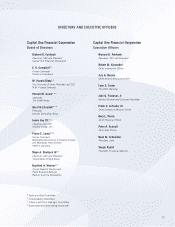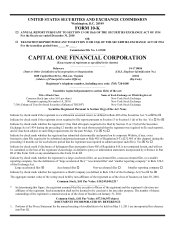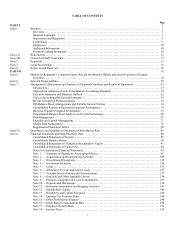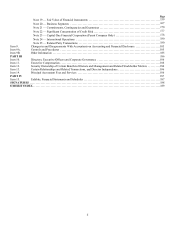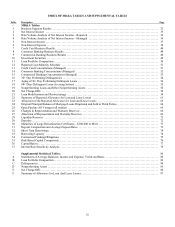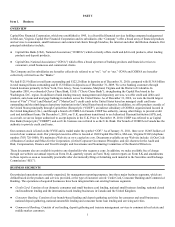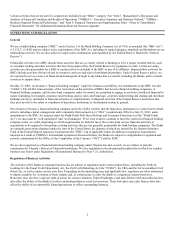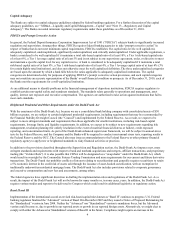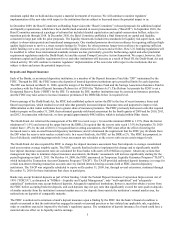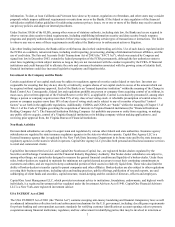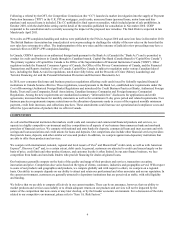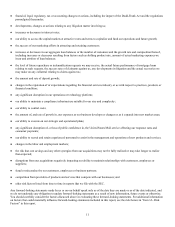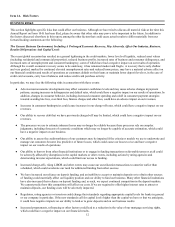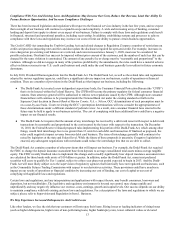Capital One 2010 Annual Report Download - page 24
Download and view the complete annual report
Please find page 24 of the 2010 Capital One annual report below. You can navigate through the pages in the report by either clicking on the pages listed below, or by using the keyword search tool below to find specific information within the annual report.4
Capital Adequacy
The Banks are subject to capital adequacy guidelines adopted by federal banking regulators. For a further discussion of the capital
adequacy guidelines, see “ MD&A—Liquidity and Capital Management—Capital” and “Note 13—Regulatory and Capital
Adequacy”. The Banks exceeded minimum regulatory requirements under these guidelines as of December 31, 2010.
FDICIA and Prompt Corrective Action
In general, the Federal Deposit Insurance Corporation Improvement Act of 1991 (“FDICIA”) subjects banks to significantly increased
regulation and supervision. Among other things, FDICIA requires federal banking agencies to take “prompt corrective action” in
respect of banks that do not meet minimum capital requirements. FDICIA establishes five capital ratio levels: well capitalized,
adequately capitalized, undercapitalized, significantly undercapitalized, and critically undercapitalized. Under applicable regulations, a
bank is considered to be well capitalized if it maintains a total risk-based capital ratio of at least 10%, a Tier 1 risk-based capital ratio
of at least 6%, a Tier 1 leverage capital ratio of at least 5% and is not subject to any supervisory agreement, order, or directive to meet
and maintain a specific capital level for any capital reserve. A bank is considered to be adequately capitalized if it maintains a total
risk-based capital ratio of at least 8%, a Tier 1 risk-based capital ratio of at least 4%, a Tier 1 leverage capital ratio of at least 4% (3%
for certain highly rated institutions), and does not otherwise meet the well capitalized definition. The three undercapitalized categories
are based upon the amount by which a bank falls below the ratios applicable to adequately capitalized institutions. The capital
categories are determined solely for purposes of applying FDICIA’s prompt corrective action provisions, and such capital categories
may not constitute an accurate representation of the Banks’ overall financial condition or prospects. As of December 31, 2010, each of
the Banks met the requirements for a well-capitalized institution.
As an additional means to identify problems in the financial management of depository institutions, FDICIA requires regulators to
establish certain non-capital safety and soundness standards. The standards relate generally to operations and management, asset
quality, interest rate exposure and executive compensation. The agencies are authorized to take action against institutions that fail to
meet such standards.
Heightened Prudential and Other Requirements under the Dodd-Frank Act
With the enactment of the Dodd-Frank Act, because we are a consolidated bank holding company with consolidated assets of $50
billion or greater, we are subject to certain heightened prudential requirements, including requirements that may be recommended by
the Financial Stability Oversight Council (the “Council”) and implemented by the Federal Reserve. As a result, we expect to be
subject to more stringent standards and requirements than those applicable for smaller institutions, including risk-based capital
requirements, leverage limits, and liquidity requirements. In addition, we expect to be subject to new requirements regarding risk
management, resolution planning (for orderly resolution in the event of material financial distress or failure), credit exposure
reporting, and concentration limits. As part of the Dodd-Frank enhanced supervision framework, we will be subject to annual stress
tests by the Federal Reserve, and the Company and the Banks will be required to conduct semi-annual stress tests, reporting results to
the Federal Reserve and the OCC. The Council also may issue recommendations to the Federal Reserve or other primary financial
regulatory agency to apply new or heightened standards to risky financial activities or practices.
In addition to the provisions described throughout the Supervision and Regulation section, the Dodd-Frank Act imposes new, more
stringent standards and requirements with respect to bank and nonbank acquisitions and mergers, affiliate transactions, and proprietary
trading (the “Volcker Rule”). It is also possible that CONA will be designated as a “swap dealer” under the Dodd-Frank Act, which
would result in oversight by the Commodity Futures Trading Commission and more requirements for our current and future derivative
transactions. The Dodd- Frank Act prohibits conflicts of interest relating to securitizations and generally requires securitizers to retain
a 5% economic interest in the credit risk of assets sold through the issuance of asset-backed securitization, with an exemption for
traditionally underwritten residential mortgage loans. The Dodd-Frank Act also includes provisions related to corporate governance
and executive compensation and new fees and assessments, among others.
The federal agencies have significant discretion in drafting the implementation rules and regulations of the Dodd-Frank Act. As a
result, the impact of the Dodd-Frank Act will not be known for many months or, in some cases, years. In addition, the Dodd-Frank Act
requires various studies and reports to be delivered to Congress which could result in additional legislative or regulatory action.
Basel II and III
Implementation of the international accord on revised risk-based capital rules known as “Basel II” continues to progress. U.S. Federal
banking regulators finalized the “Advanced” version of Basel II in December 2007 and they issued a Notice of Proposed Rulemaking for
the “Standardized” version in June 2008. Neither the “Advanced” nor “Standardized” version is mandatory for us, but the Advanced
version could become so, due to growth in our reported assets or growth in our reported foreign assets. Alternatively, we might elect to
comply with either the Advanced or Standardized versions of Basel II in the future. Compliance might require an increase in the



